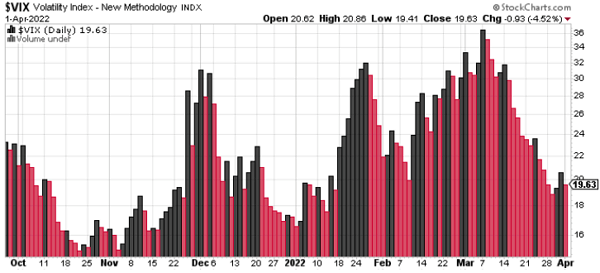Weekly Market Review & Analysis For March 28, 2022

The S&P 500 market registered an 0.1% gain for the week, easing off an upbeat beginning. The Dow Jones Index also decreased by 0.1%, while the small-cap Russell 2000 increased by 0.6%, and the almighty Nasdaq Composite concluded by rising 0.7%.
From a market sector perspective, the financials with -3.3%, energy with -2.4%, and industrials posting -1.5% were sectors that were among the worst-performing. In comparison, real estate with +4.4%, utilities with +3.7%, and consumer staples adding +2.3% were the sectors that did well and posted solid gains.
The first two days of trading this week witnessed an increase in positive momentum. Apple has been in positive territory for eleven straight trading sessions. Stocks climbed even as Two-year and Ten-year note spreads for a little while inverted on Tuesday session. The inversion could indicate an economic recession that could last for 6 to 24 months following the inversion.
However, the market reversed its gains over the following few days, as the main PCE Price Index for February, posting +5.4%, was the highest subsequently since 1983. The employment report for March raised expectations for an even more aggressive Fed action, and investors and traders took profits and adjusted their portfolios accordingly for the end of the quarter.
The employment numbers were positive, with decent job growth (over 400k for both private-sector and non-farm payrolls), which is a higher than the expected employment rate of 3.6% and an anticipated 0.4% rise in the average hourly wages.
In the wake of the report, the spread of Two-year and Ten-year notes reverted due to concerns about a Fed monetary policy error. At the end of the week's market session, the yield on the Two-year note was increased by fourteen basis points up to 2.43%, and the Ten-year yield dropped by 11 basis points and was at 2.38 0. In the meantime, the U.S. Dollar Index increased by 0.2% to close the week at 98.56.
Crude oil prices dropped $14.29 or 12.6% and concluded the trading week at $99.36/bbl following the U.S. and other IEA nations' announcement that they would release crude oil reserves for strategic reasons to reduce high gasoline prices. It is expected that the U.S. plans to release 1 million barrels of crude oil daily for the upcoming six months. OPEC+ agreed to raise its oil production objectives by 432,000 barrels per day next month in related market news.

Market elsewhere
The market(s) ingested a variety of economic news, highlighted by the Eurozone forecasting March's inflation of consumer prices at a record level of 7.5% year to year, an increase from the 5.9% rate posted in February. The March Eurozone and U.K. Manufacturing PMIs were revised lower than published initially; however, both remain in the expansion range. The British pound and Eurodollar were lower against the U.S. dollar, and the U.K. and Eurozone bond yields climbed higher.
Stocks in the Asia region ended up mixed to close the week on a choppy note. Markets being on edge continue to keep an eye on the conflict within Eastern Europe and prospects for more monetary policy easing in the U.S. and Europe to stop the escalating inflationary pressures.
The gold and silver market floated lower on corrective this week, clearly caught in a holding pattern while traders and investors tried to emphasize news developments in Europe. Gold traded at $1,924, drifting lower by $34 from last Friday's close session, and silver traded at $24.61, falling 87 cents on the week's session.
In the wake of U.S. and European market(s) having had their worst quarter since the pandemic crash in 2000, Gold Futures gained 6.6% during the turbulent first quarter. The safe-haven yellow metal traded in the $300 range concluded the quarter outside of $1,950, an all-time highest closing. Comex Gold Futures gained more for a quarter on the most recent occasion in Q2 of 2020, when the yellow metal rose by 14%.
Bitcoin
As of Friday, there are 19 million bitcoins in circulation. This means there are only 2 million left to be mined. Due to the maximum amount of bitcoin - 21 million - bitcoin is scarce. The inflow will only decrease in the coming years.
When will the last bitcoin be mined?
The bitcoin algorithm states that the last bitcoin will be mined around 2140. Thus, the current 2 million mining will be spread over the next 118 years. These are put into circulation by people who mine bitcoins, and this is also the only way bitcoins are made.
What will this do with the market price?
When the milestone of 18 million bitcoin was reached, this didn't significantly impact the price. In October 2019, during the '18 million milestones', the price did virtually nothing. At a psychological level of 20 million bitcoin, or 21 million in 2140 - which we hope to witness - this could have more effect.
This article was printed from TradingSig.com